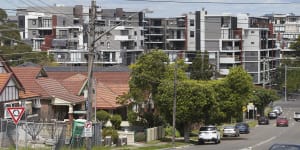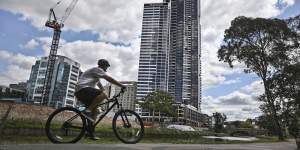But a seller’s chance of losing money depends on property type,as even in areas where many apartments sell at a loss,houses nearby are highly likely to make a profit.

The highest proportion of loss-making sales in Sydney was in the Strathfield LGA at 23.8 per cent,the CoreLogic Pain and Gain Report,released on Wednesday,found.
It was followed by Burwood (23.2 per cent),Parramatta (22.4 per cent),Botany Bay (21 per cent) and Ryde (20.2 per cent).
Property sellers are more likely to profit than lose money and their prospects have been improving. Australia-wide 94 per cent of sales made a gain during the December quarter,up from 93.6 per cent three months earlier. Across Sydney 91.9 per cent of sales made a profit,up from 91.3 per cent in the previous quarter.
CoreLogic research director Tim Lawless said the property market had only a short,sharp downturn and there was not a prolonged period where profit-making sales were reduced.

Unit owners were more likely to sell for a loss in high-density areas than house owners.Ben Rushton
The quarterly results reflected the fact property values were rising for most of last year,he said.
“Most people who have resold their home have held their property through the pandemic growth period,if not longer than that,” he said.
He said rising interest rates and the cost of living would make it harder for borrowers to pay their loans,and mortgage arrears had started to rise but from very low levels and remained lower than before the pandemic.
“Most borrowers are going to be in a positive equity position and if they need to sell they can probably do so proactively and sell their home for more than what they paid for it,” he said.
“Generally,we find investors are more willing to incur a loss on their resales simply because you remove the emotion from the decision.”
He said many of the areas with higher rates of loss-making sales were high-density,high-supply neighbourhoods where detached housing had higher scarcity value and capital growth than units.
In Strathfield,for example,even though 25.7 per cent of unit sales made a loss,none of the house sales lost money. Botany Bay and Parramatta had high unit losses but few or zero house losses.
But he added that higher supply and densification had a silver living as it could help limit housing price growth.

In neighbourhoods such as Parramatta,some properties are selling at a loss.Ben Rushton
“The fact we have seen more supply being introduced to unit markets in a lot of these higher density areas is a really positive thing because it does help to keep a lid on housing affordability,” he said.
A previous Productivity Commission study found housing,while a recent NSW Productivity Commission report also found higher density could reduce apartment prices and rents and stall the exodus of young people. The report warned Sydney.
AMP chief economist Dr Shane Oliver said he expected the highest proportion of loss-making sales to be in unit-heavy suburbs.
“The common factor seems to be areas that have a high level of units. Areas that are dominated by houses,you tend to get less loss-making,” he said. “Those areas have been somewhat stronger.”
Oliver said house and unit prices would also affect the proportion of loss-making sales. Low unit price growth would lessen the opportunity for apartment owners to make a profit.
Affordability was also a factor;Oliver said apartment purchasers may not have the cash to buy into the safer investment,houses.
A high proportion of loss-making sales in Parramatta and Strathfield,Ryde and Burwood councils could be linked to the number of units in those local government areas,Oliver said.
“They tend to have high unit exposure,a lot were put up in the apartment building boom … There’s been a lot of investors offloading their property because the interest rate yield equation has become less favourable. In other words the rents would not be covering the mortgage rates.”
Buyer’s agent Rich Harvey said the pockets of loss-making sales were due to a mismatch of supply and demand.
He said some of these neighbourhoods have had their height limits increased and many new apartments built.
“Parramatta is a great second CBD,but if you’re looking to buy a property for significant capital growth don’t go and buy the same type of property that can be substantially increased in supply. One of the key things to be a successful investor is to buy something with relative scarcity,” he said,suggesting properties with a higher land component.
“You can better quality apartments in smaller boutique blocks that are better positioned with access to amenities and restricted development potential.”